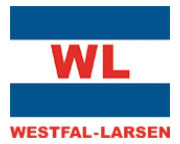|
Vaughan Family Timestream® Maps |
| Home Biography People Places Multimedia: Making It Work On the Water Writings/Presentations |
About Westfal-Larsen A/S

Selected content from TheShipsList®™ - (Swiggum) Last updated: October 11, 2008 and maintained by S. Swiggum and M. Kohli...
Westfal-Larsen A/S, Bergen, Norway 1905-2005
Hans Peter Westfal-Larsen born in 1872 learned the trade by Rasmus F. Olsen Shipping Company for 16 years before he started his ship owning activities in 1905 by purchasing his first ship the HARDANGER built in Bergen and consolidated and incorporated his companies in 1918 as Westfal-Larsen & Co. A/S.
In spite of Norway’s neutrality during World War I Westfal-Larsen & Co. A/S lost 11 ships during this period, the s/s Prosper III being mined on 6 June 1916 was one of most tragic losses for the Company, 29 lives were lost.
The company has been engaged in the owning of tanker vessels, operated liner services between North and South America and North America and Europe as well as tramp vessels in world wide trade.
In 1921 a liner service ; the County Line was set up with three other Bergen shipping companies to the East Coast of North America as well as the Continent and in 1925 Westfal-Larsen & Co. A/S started a service between the West Coast of North America and around South America, bringing timber and fruit south and returning with coffee.
In 1930 Interocean Line was established navigating between the West Coast of North America and Europe via the Panama Canal and provided some passenger accommodation on their cargo ships.
The Southern Cross Line between North and South America was established in 1939 with the J. Ludwig Mowinckel Shipping Company also with some passenger accommodation on their cargo ships.
The Company’s first tanker the MALMANGER was sunk during World War I, a new MALMANGER was delivered in 1920, followed by the DAVANGER in 1922, later followed the VARANGER and NORDANGER of 1925 built by the Dutch shipbuilders Nederlandsche Scheepsbouw Mij., Amsterdam.
In 1939 a fleet of a dozen tankers was owned, several of which became war casualties as well as most of the fleet of North and South Pacific cargo ships. During World War II Westfal-Larsen & Co. A/S lost 22 ships out of a fleet of 36 ships. In
1940 alone, 5 ships were lost and 54 crew members perished at sea.
The fleet was rebuilt with a dozen new cargo ships and tankers with the STORANGER of 33,000 dwt being delivered in 1959 from Rosenberg Mek. Verksted, Stavanger being the biggest. The Interocean Line was re-established after the war with standard ships C-1-A bought from US surplus. Flag discrimination in South America towards the end of the fifties forced Westfal-Larsen & Co. A/S to leave the County Line in 1958 and the Southern Cross Line was ended two years later. The Interocean Line stopped in 1970. The shipping company’s participation in the traditional liner trade was over and Westfal-Larsen & Co. A/S concentrated on bulkcarriers and tankers.
The bulk carriers were operated in the Star Shipping pool, Star Shipping, was founded in 1961 and owned by two major ship-owners; Grieg Shipping AS and Masterbulk Pte. Ltd., the latter wholly owned by the Westfal-Larsen family. There was a 50% interest obtained in Odfjell Westfal-Larsen Tankers.
In 1989 a VLCC of 357,000 dwt was purchased and renamed SAMNANGER.
Presently in 2005 the company owns and manages chemical tankers, Open Hatch bulk carriers and a very large LPG carrier from its main office in Bergen, Norway.
The family shareholders also own and operate their 50% interest in Star Shipping AS from Singapore. Star Shipping is a major participant in handy size and open hatch type bulk carriers, focusing on industrial shipping.
Westfal-Larsen Management AS was incorporated in 1996 as the result of a demerger from Westfal-Larsen & Co. A/S. The company has taken over the whole staff and pension liabilities.
The main purpose of the Westfal-Larsen Management AS is to be a resource base for other companies within the Westfal-Larsen Group as regards general management, accounting, operation, technical management of ships and new building projects.
Many thanks to Henk Jungerius and Ted Finch for his assistance in collecting this data. The following list was extracted from various sources. This is not an all inclusive list but should only be used as a guide. If you would like to know more about a vessel, visit the Ship Descriptions (onsite) or Immigrant Ship web site.
Routes:
San Francisco, Los Angeles, Bahia Blanca, Buenos Aires, Montevideo, Santos, Rio de Janeiro, Cristobal, Balboa, Los Angeles, San Francisco. (1927).
San Francisco, Los Angeles (Long Beach), Buenaventura, Guayaquil, Callao, Arica, Antofagasta, Valparaiso, Buenos Aires, Montevideo, Santos, Rio de Janeiro, Bahia, Recife, Sao Luiz, Para, Trinidad, Barbados, La Guaira, Barranquilla, Cristobal, Central American ports (Pacific coast), Los Angeles (Long Beach), San Francisco. (1959).
San Francisco, Los Angeles, Acapulco, Buenaventura, Guayaquil, Callao, Valparaiso, Punta Arenas, Montevideo, Buenos Aires, Santos, Rio de Janeiro, Port of Spain, Barranquilla, Cartagena, Cristobal, Buenaventura, Los Angeles, San Francisco. (1970).
Rotterdam, Panama Canal, Los Angeles, San Francisco, Portland, Seattle, Vancouver. Return voyages: Vancouver, Seattle, Portland, San Francisco, Los Angeles, Panama Canal, Le Havre, Antwerp, Rotterdam, London (occasional calls) (Interocan Line). (1938).